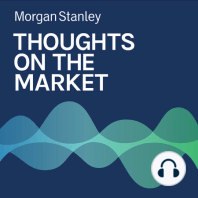3 min listen

Matthew Hornbach: The Fed Pivot That Wasn’t Quite As It Seemed
Matthew Hornbach: The Fed Pivot That Wasn’t Quite As It Seemed
ratings:
Length:
4 minutes
Released:
Aug 3, 2022
Format:
Podcast episode
Description
After the July FOMC meeting, markets took a quick dive and then made an immediate recovery, so what happened?-----Transcript-----Welcome to Thoughts on the Market. I'm Matthew Hornbach, Global Head of Macro Strategy for Morgan Stanley. Along with my colleagues, bringing you a variety of perspectives, I'll be talking about global macro trends and how investors can interpret these trends for rates and currency markets. It's Wednesday, August 3rd, at 1 p.m. in New York. In the weeks since the July meeting of the Federal Open Market Committee, or FOMC, rates and currency markets have made quite the round trip. Treasury yields from 2 out to10 year maturities fell by over 25 basis points in the three days that followed the meeting. And the U.S. dollar index declined by 2% over the same period. However, looking at these markets today, as I sit here recording this podcast, it's almost as if the July FOMC meeting didn't happen. 10 year Treasury yields are about where they were going into the meeting last week, and 2 year yields are a bit higher even. As for the U.S. dollar index, it's back to the range it was in ahead of the meeting. So what happened? Going into the meeting, investors thought that the Fed would deliver a 75 basis point rate hike, but recognized that there was a tail risk of a larger 100 basis point hike. And even if the tail risk didn't materialize, investors had acknowledged that the additional 25 basis points might be delivered in September instead. And that would make for the third 75 basis point hike in this cycle. In short, investors were positioned for a hawkish outcome. The FOMC statement and Chair Powell's prepared remarks didn't disappoint. The message was on par with what FOMC participants had been saying over recent weeks and months. Inflation is still top of mind, and more work is needed to bring it down to acceptable levels. If the meeting ended with Powell's prepared remarks, rates and currencies would have likely taken a different path to where they trade today. However, the meeting didn't end there, and the Q&A session of Powell's press conference struck a more dovish tone. Three messages contributed to this interpretation. First, Powell suggested that rates had achieved a neutral setting, or one that neither puts upward nor downward pressure on economic activity relative to its potential. Second, he said that because a neutral policy setting had been reached, the pace of subsequent rate hikes could soon begin to slow. And finally, he suggested that the committee's view of the peak policy rate in the cycle hadn't changed since the last FOMC meeting, even though inflation data since then continued to surprise on the higher side. The reason for this seemed to be focused on the deterioration in activity data or growth data. In many ways, investors should have expected these statements from Powell, given guidance coming from the June summary of economic projections. In addition, because Fed policy had tightened financial conditions this year, and those financial conditions helped slow economic growth, the case for a less hawkish performance might have been predictable. The data that arrived in the wake of the meeting underscored the recent themes of slower growth and higher inflation. But the Fedspeak that arrived in the wake of the data, well, it continued to focus on inflation, as it had done before the Fed met in July. Where does all of that leave the Fed on policy and us on markets? Well, the Fed's job bringing inflation down hasn't yet been accomplished, the bond market is pricing less policy tightening than the Fed is last guided towards, and downside risks to global growth are rising. As a result, we remain neutral on bond market duration, but remain bullish on the U.S. dollar, particularly against the euro. Thanks for listening. If you enjoy Thoughts on the Market, please take a moment to rate and review us on the Apple Podcast app. It helps more people find the show.
Released:
Aug 3, 2022
Format:
Podcast episode
Titles in the series (100)
Mike Wilson: Are U.S. Economic Indicators Flashing Yellow? by Thoughts on the Market